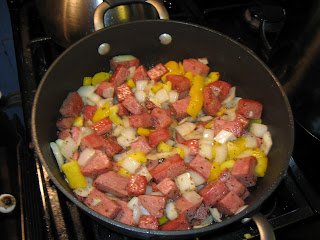 In the place of an absent father I was fortunate to spend many of my childhood years with my grandparents. They lived at the end of a rail line in outback Queensland, Australia, in the pioneer town of Springsure with about 300 people. The large house with verandas all around had no electricity and no indoor plumbing. Drinking water came from rainwater and "hard" water came from a well and windmill. Between grandma's chickens and grandpa's huge garden watered by the windmill, food was plentiful. Grandma's cooking on the cast iron wood stove is still a strong and very pleasant memory of the sights and smells.
In the place of an absent father I was fortunate to spend many of my childhood years with my grandparents. They lived at the end of a rail line in outback Queensland, Australia, in the pioneer town of Springsure with about 300 people. The large house with verandas all around had no electricity and no indoor plumbing. Drinking water came from rainwater and "hard" water came from a well and windmill. Between grandma's chickens and grandpa's huge garden watered by the windmill, food was plentiful. Grandma's cooking on the cast iron wood stove is still a strong and very pleasant memory of the sights and smells. |
| Judy - My Wife - My Best Friend - My Mate |
This dish, Judy's Spacken Chili, is a Phase 2 dish and was designed to wife Judy's requirements. If the sunday meat was finished then canned meat from the pantry could be used with the leftover vegetables from the Sunday meal"Spacken" my recipe in which I replace chicken with Spam. You can of course use either Spam of chicken. Cans of Spam or Bully Beef, a reserve food in most outback pantries, were often needed in times of floods and bush fires. Spam is a favorite dish from Judy's childhood. For more information on Spam see previous blog.
Phase 2: Chicken, Rice and Vegetable Soup.
Ingredients
2 quarts of chicken broth - Grandma made it from long, slow boiling of leftovers on the back of the stove.
1 quart of water

4 cups of chopped chicken leftovers
2 medium chopped onions
2 cups of chopped celery
2 cups of sliced carrots into 1 inch pieces
1 small Uncle Ben's 6 oz. Long grain & wild rice original recipe packet.
This rice packet adds both white and wild rice as well an excellent selection of blended spices.
1 teaspoon each of salt, pepper, and garlic powder, or in place of the garlic powder use (my preference) one teaspoon of Mrs Dash's Blend of Tomato, Basil and Garlic.
Add all the ingredients to a pot and slow boil for an hour.
This should serve 6 people.
 Phase 2: Judy's Spacken Chili
Phase 2: Judy's Spacken ChiliIngredients
2 - 3 quarts of leftover Phase 1 soup
3 cans of Spam
1 can 28 oz. Bush baked beans - Country Style (includes bacon and brown sugar)
1 can 19 oz. Cannellini beans
1 can 16 oz. diced Italian tomatoes
1 bell pepper
2 medium onions
1/2 cup olive oil
2 tablespoons of chili powder.
1 teaspoon curry powder

1/4 cup Worcestershire Sauce
4 packets of Equal (sugar substitute)
1 teaspoon salt
1 teaspoon pepper
1 teaspoon garlic powder or 1 teaspoon Mrs. Dash blend of tomato, basil and garlic (my preference)
1 cup Spicy Hot V8 Juice
1 can 12 oz. tomato paste
Chop the Spam into 1 inch cubes. Brown in a pan with the olive oil, add the chopped onions and bell pepper and saute.
Combine all ingredients in a stock pot and allow to simmer for at least 45 minutes while stirring well.
Place the contents in 8-10 one-quart canning jars. This makes a great meal in a hurry for guests who arrive with limited notice.

This is not a thick chili. Judy prefers her chili "brothy" or soupy. The tomato paste does make the mixture thicker. Add a cup of dried potato flakes to make the traditional thick texture. Simmering on a slow boil for at least an hour does reduce liquid. You will need to stir well.


No comments:
Post a Comment